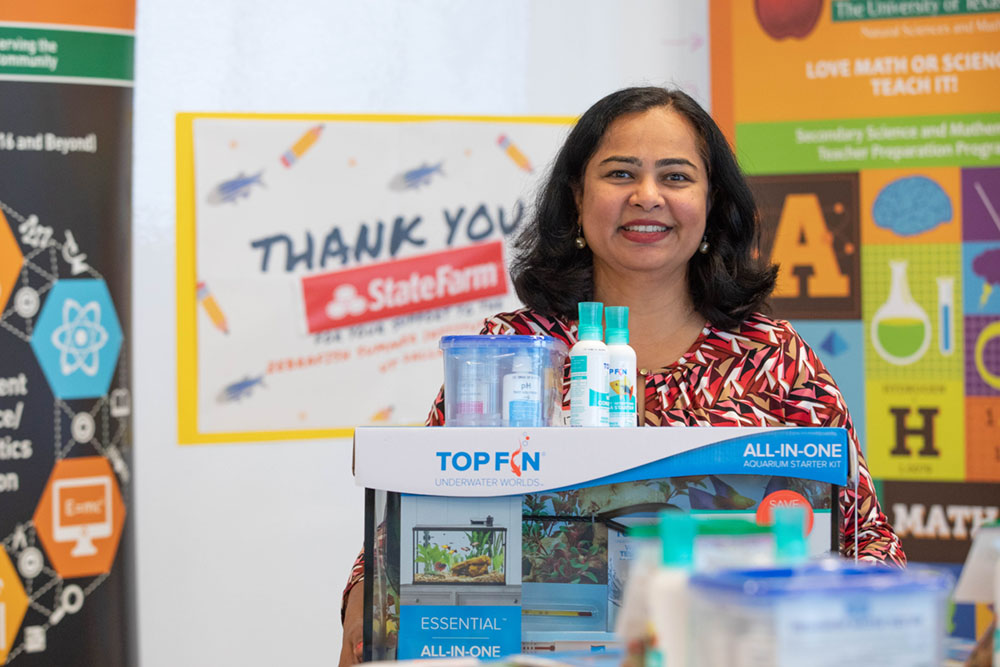Summer Science Program Makes Splash with Texas Teachers
By: Paul Bottoni | Sept. 15, 2021

A program at The University of Texas at Dallas is helping teachers spark curiosity and provide real-world applications to scientific concepts via a small addition to their classrooms — zebrafish.
Dr. Vinita Hajeri, assistant professor of instruction in the Department of Science/Mathematics Education in the School of Natural Sciences and Mathematics, started the Zebrafish Summer Institute in 2018 to give kindergarten through 12th-grade teachers a low-cost method to drive home science lessons with their students.
“During my postdoctoral training with zebrafish at UT Southwestern Medical Center, I was very active in doing outreach with schoolchildren,” Hajeri said. “I realized the kids get really excited with zebrafish, but I wasn’t leaving the teachers with a model to continue using the fish in their lessons.”
Zebrafish are at the forefront of biological research, helping scientists understand complex diseases, including cancer. According to the National Institutes of Health, 70% of human genes are found in these fish; for instance, Duchenne muscular dystrophy and human melanoma have been successfully modeled in zebrafish. Recently, UT Southwestern researchers developed a zebrafish model for the childhood cancer rhabdomyosarcoma.


Zebrafish are also ideal for classrooms for a number of reasons: They are freshwater fish that can be found at local pet stores; they can be easily maintained in a classroom aquarium; and students can practice several scientific concepts while studying them — from collecting data and monitoring the tank habitat, to developing hypotheses and writing about their findings.
“One of the major struggles teachers have is engaging students with authentic scientific experiments with no access to research-grade equipment. To mitigate this problem, our lab is actively involved in creating zebrafish apparatus using recyclable materials and simplified methods that allow teachers to teach with zebrafish. The program also provides yearlong support to all educators from the institute,” Hajeri said. “Working with zebrafish allows students to conduct experiments at minimal costs, such as investigating patterns of vertebrate embryonic development and identifying commonalities shared between human and zebrafish embryos.”
The institute — which typically lasts a week, and collaborates with the STARS program at UT Southwestern and faculty at UT Arlington — was canceled last year because of the COVID-19 pandemic, but it returned this summer in a condensed, hybrid format.
“One of the major struggles teachers have is engaging students with authentic scientific experiments with no access to research-grade equipment. To mitigate this problem, our lab is actively involved in creating zebrafish apparatus using recyclable materials and simplified methods that allows teachers to teach with zebrafish.”
Dr. Vinita Hajeri, assistant professor of instruction in the Department of Science/Mathematics Education in the School of Natural Sciences and Mathematics
Sixteen Texas teachers — some from as far away as Corpus Christi and Pflugerville — attended this summer’s program. The group first met online in a morning workshop to learn background information and then spent the next day gaining hands-on experience with zebrafish in Hajeri’s lab in the Science Learning Center on the UT Dallas campus. This year the program focused on making science accessible to diverse learners — including English language learners — with the collaborative efforts of Pam Kirkland, master teacher at UT Dallas, and Dr. Jennifer Burr of Region 10 Education Service Center.
The program received $6,500 from State Farm through the company’s Enterprise Technology Priority School Grant. State Farm selected the Zebrafish Summer Institute because of its potential to impact students. The funds helped purchase aquariums for attendees so they could set up zebrafish in their own classrooms.
Bibiana Mendez, a biology teacher at Nimitz High School in Irving, attended the institute in 2019 after hearing about the program from Hajeri at a conference.
“Right away I began gathering equipment and everything I needed for the lessons. My kids went nuts over them,” Mendez said. “They had me train them on how to take care of the fish. It became this revolutionary thing in the classroom.

“It gave them a real-life situation that they could see and manipulate, and it wasn’t something abstract.”
Mendez has since taught fellow educators about raising zebrafish and spoke to attendees of this summer’s institute about how to introduce the fish into their lesson plans.
Samara Lowe BA’19, who teaches at Legacy Preparatory Charter Academy in Mesquite, was one of this year’s attendees. She also took one of Hajeri’s classes when she was a biology senior at UT Dallas, and she credits Hajeri for inspiring her to become a teacher.
Lowe said she has already introduced the zebrafish in her classroom this year, and her students are enthusiastic.
“This will solidify biology concepts for our seventh graders and give them a practical application of science,” Lowe said.
Media Contact:
Paul Bottoni, UT Dallas, 972-883-3522, paul.bottoni@utdallas.edu, or the Office of Media Relations, UT Dallas, (972) 883-2155, newscenter@utdallas.edu.





